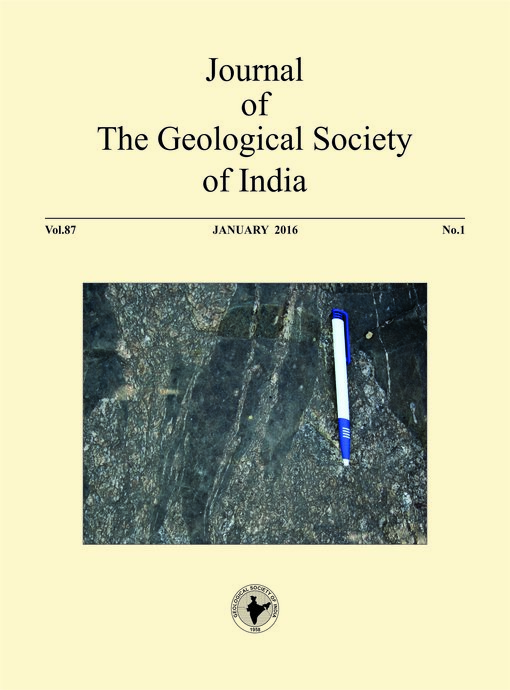Earthquake Triggered Landslide - Indian Scenario
Keywords:
Earthquakes, Landslides, Himalaya.Abstract
Landslide initiation due to earthquake is one of the most prevalent seismic hazard, which claims hundreds of lives in the Himalayan mountainous terrains of India. Number of landslides, maximum distance from the epicentre and total landslide area/volume are correlatable with earthquake magnitudes. Application of globally accepted earthquake triggered landslide parameter models do not match well with published data for the Himalayan earthquake triggered landslides. Considering the incompleteness of landslide inventories for most of the Himalayan earthquakes, development of regression equations show that in the Himalayan environment, landslide may trigger even with imperciptable earthquakes affecting longer distances having earthquake magnitude of more than 8 M with potential to affect more areas than the global expectations.Downloads
Issue
Section
Downloads
Published
How to Cite
References
AUDEN, J.B. (1949) A geological discussion on the Satpura hypothesis and Garo-Rajmahal gap. Proc. Natl. Inst. Sci. India, v.15.
BARNARD, P.L., OWEN, L.A., SHARMA, M.C. and FINKEL, R.C. (2001) Natural and human-induced landsliding in the Garhwal Himalaya of northern India. Geomorphology, v.40, pp.21-35.
BILHAM, R. and ENGLAND, P. (2001) Plateau pop-up in the 1897 Assam earthquake. Nature, v.410, pp.806-809.
DAVISON, C. (1936) Great Earthquakes. Th. Murby, London, pp.138-157.
GHOSH, S., CHACKRABORTY, I., BHATTACHARYA, D., BORA, A. and KUMAR, A. (2012) Generating field-based inventory of earthquake-induced landslides in the Himalaya- an aftermath of the 18 September 2011 Sikkim Earthquake. Indian Jour. Geosci., v.66, pp.27-38.
HANCOX, G.T., PERRIN, N.D. and DELLOW, G.D. (2002) Recent Studies of Historical Earthquake-Induced Landsliding, Ground Damage, and MM Intensity in New Zealand: Bull. New Zealand Soc. Earthquake Engg., v.35, pp.59-94.
JIBSON, R.W., HARP, E.L., SCHULZ, W. and KEEFER, D.K. (2004) Landslides triggered by the 2002 Denali Fault, Alaska, earthquake and the inferred nature of the strong shaking. Earthquake Spectra, v.20, pp.669-691.
KAMP, U., GROWLEY, B.J., KHATTAK, G.A. and OWEN, L.A. (2008) GIS-based landslide susceptibility mapping for the 2005 Kashmir earthquake region. Geomorphology, v.101, pp.631-642.
KEEFER, D.K. (1984) Landslides caused by earthquakes.: Geol. Soc. Amer. Bull., v.95, pp.406-421.
KEEFER, D.K. (2002) Investigating landslides caused by earthquakes – a historical review: Surveys in Geophysics, v.23, pp.473-510.
KEEFER, D.K. (2013) Landslides Generated by Earthquakes: Immediate and Long-Term Effects. Treatise on
Geomorphology, v.5, San Diego, Elsevier Inc., pp.250-266.
LEI, C.I. (2012) Earthquake-Triggered Landslides: 1st Civil and Environmental Engineering Student Conference, Imperial College London, pp.1-6.
MALAMUD, B. D., TURCOTTE, D. L., GUZZETTI, F. and REICHENBACH, P. (2004) Landslides, earthquakes, and erosion. Earth Planet. Sci. Lett., v.229, pp.45-59.
MARTHA, T.R., BABU GOVINDHARAJ, K. and VINODKUMAR, K. (2014) Damage and geological assessment of the 18 September 2011 Mw 6.9 earthquake in Sikkim, India using very high resolution satellite data Geoscience Frontiers, D.O.I. j.gsf.2013.12.011
MATHUR, L.P. (1953) Assam earthquake of 15th Aug., 1950-a short note on factual observations. The Central Board of Geophysics, v.1, pp.56-60.
OLDHAM, R. D. (1899) Report on the great earthquake of 12th June 1897. Mem. Geol. Surv. India, v.29.
OWEN, L.A., KAMP, U., KHATTAK, G.A., HARP, E.L., KEEFER, D.K. and BAUER, M.A. (2008) Landslides triggered by the 8 October 2005 Kashmir earthquake. Geomorphology, v.94, pp.1-9.
PACHAURI, A.K., GUPTA, P.V. and CHANDER, R. (1998) Landslide zoning in a part of Garhwal Himalaya. Environ. Geol., v.36, pp.325-334.
PEIRIS, N., ROSSETTO, T., BURTON, P. and MAHMOOD, S. (2006) October 8, 2005 Kashmir Earthquake, London, U.K., The Institution of Structural Engineers, p. 31.
RAJENDRAN, K., RAJENDRAN, C.P., JAIN, S.K., MURTY, C.V.R. and ARLEKAR, J.N. (2000) The Chamoli earthquake, Garhwal Himalaya: Field observations and implications for seismic hazard. Curr. Sci., v.78, pp.45-51.
SARKAR, I., PACHAURI, A.K. and ISRAIL, M. (2001) On the damage caused by the Chamoli earthquake of 29 March, 1999. Jour. Asian Earth Sci., v.19, pp.129-134.
SIMONETT, D.S. (1967) Landslide Distribution and Earthquakes in the Bewani and Torricelli Mountains, New Guinea – a Statistical Analysis. Cambridge University Press, Cambridge, pp.64-84.
SOM, S.K. (2014) Seismological report on Sikkim earthquake of 18th September 2011. In: S.K. Som, A. Datta, A. Mohanty and R.P. Chourasia (Eds.), Geol. Surv. India Bull., Series-B, pp.60.
VINODKUMAR, K., MARTHA, T.R. and ROY, P.S. (2006) Mapping damage in the Jammu and Kashmir caused by the 8 October 2005 Mw 7.3 earthquake from the Cartosat-1 and Resourcesat1 imagery. Internat. Jour. Remote Sensing, v.27, pp.4449-4459.
VOHRA, C.P. and SARMA, D.G. (1992) Uttarkashi Earthquake, Calcutta. Geol. Surv. India, Spec. Publ., no.30, pp.217.

 Harbans Singh
Harbans Singh


